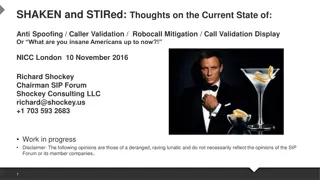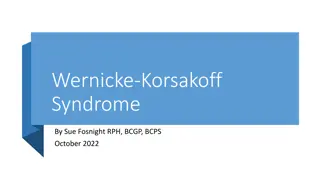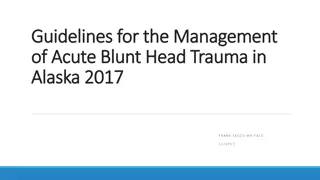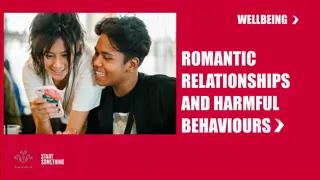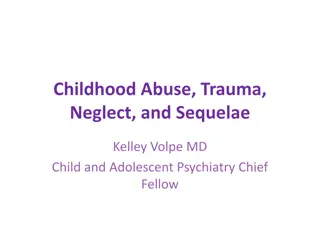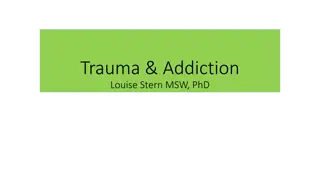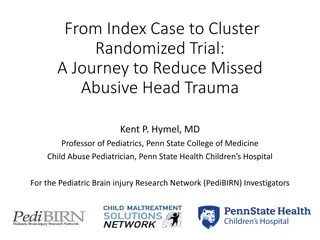Understanding Shaken Baby Syndrome and Abusive Head Trauma
Abusive head trauma, commonly known as Shaken Baby Syndrome (SBS), is a severe form of child abuse that results in brain injury. It is a leading cause of physical child abuse deaths in children under 5 in the United States. Recognizing the signs and symptoms, understanding the causes, diagnosis, developmental effects, and prevention strategies are crucial in combating this devastating form of abuse.
Download Presentation

Please find below an Image/Link to download the presentation.
The content on the website is provided AS IS for your information and personal use only. It may not be sold, licensed, or shared on other websites without obtaining consent from the author. Download presentation by click this link. If you encounter any issues during the download, it is possible that the publisher has removed the file from their server.
E N D
Presentation Transcript
Child Care Basics Series Module 1: Shaken Baby Syndrome/Abusive Head Trauma/ Mandated Reporter: Child Abuse
Shaken Baby/Abusive Head Trauma
SBS/AHT What Is Abusive Head Trauma? Abusive head trauma, also called shaken baby syndrome (or SBS), goes by many other names, including inflicted traumatic brain injury and shaken impact syndrome. All of these names mean the same thing: an injury to a child's brain as a result of child abuse
Abusive Head Trauma Facts Abusive head trauma is a leading cause of physical child abuse deaths in children under 5 in the United States. Abusive head trauma accounts for approximately one third of all child maltreatment deaths. The most common trigger for abusive head trauma is inconsolable crying. Babies less than one year old are at greatest risk of injury from abusive head trauma.
Abusive Head Trauma Causes Direct blow to head Dropping child Vigorously shaking child Striking child s head against a surface
Signs & Symptoms Unconscious Seizures lethargy irritability vomiting poor sucking or swallowing decreased appetite lack of smiling or vocalizing rigidity seizures difficulty breathing blue color due to lack of oxygen altered consciousness unequal pupil size an inability to lift the head an inability to focus the eyes or track movement
Diagnosis If shaken baby syndrome is suspected, doctors may look for: hemorrhages in the retinas of the eyes skull fractures swelling of the brain subdural hematomas (blood collections pressing on the surface of the brain) rib and long bone (bones in the arms and legs) fractures bruises around the head, neck, or chest
Developmental Effects Brain injury Language Vision Balance Motor coordination
Prevention Parent & Caregivers Understand that infant crying is worse in the first few months of life, but it will get better as the child grows. Try calming a crying baby by rocking gently, offering a pacifier, singing or talking softly, taking a walk with a stroller, or going for a drive in the car. If the baby won t stop crying, check for signs of illness and call the doctor if you suspect the child is sick. If you are getting upset or losing control, focus on calming yourself down. Put the baby in a safe place and walk away to calm down, checking on the baby every 5 to 10 minutes. Call a friend, relative, neighbor, or parent helpline for support. Never leave your baby with a person who is easily irritated or has a temper or history of violence.
Prevention: 5 Ss All babies cry: educate parents and caregivers on how to respond when an infant cries. 1. Shushing (by using "white noise" or rhythmic sounds that mimic the constant whir of noise in the womb. Vacuum cleaners, hair dryers, clothes dryers, a running tub, or a white noise machine can all create this effect.) 2. Side/stomach positioning (placing the baby on the left side to help with digestion or on the belly while holding him or her. Babies should always be placed on their backs to sleep.) 3. Sucking (letting the baby breastfeed or bottle-feed, or giving the baby a pacifier or finger to suck on). 4. Swaddling (wrapping the baby in a blanket like a "burrito" to help him or her feel more secure. Hips and knees should be slightly bent and turned out). 5. Swinging gently (rocking in a chair, using an infant swing, or taking a car ride to help duplicate the constant motion the baby felt in the womb).
If a baby in your care won't stop crying, you can also try the following Make sure the baby's basic needs are met (for example, he or she isn't hungry and doesn't need to be changed). Check for signs of illness, like fever or swollen gums. Rock or walk with the baby. Sing or talk to the baby. Offer the baby a pacifier or a noisy toy. Take the baby for a ride in a stroller or strapped into a child safety seat in the car. Hold the baby close against your body and breathe calmly and slowly. Give the baby a warm bath. Pat or rub the baby's back. Call a friend or relative for support or to take care of the baby while you take a break. If nothing else works, put the baby on his or her back in the crib, close the door, and check on the baby in 10 minutes. Call your doctor if nothing seems to be helping your infant, in case there is a medical reason for the fussiness.
Mandated Reporter: Child Abuse
Mandated reporters provide the safety net to protect children in our communities. Laws in all 50 states and the District of Columbia provide terms for filing and responding to reports of the abuse and neglect of children
Types of abuse Neglect Physical Abuse Emotional Abuse Sexual Abuse
Caregivers Parents/guardians Other relatives/older siblings Foster parents Child care providers Babysitters Teachers/educators Live-in partners of parents, even if only caring for child occasionally
Neglect Neglect is defined as; Failure to provide, by those responsible for the care, custody, and control of the child, the proper or necessary support, education as required by law, nutrition or medical, surgical, or any other care necessary for the child s well-being.
Warning signs of Neglect Possible signs of neglect could include: Soiled clothing or clothing not appropriate for the weather Signs of hunger, hoarding or stealing food, poor nutrition Listlessness or fatigue Poor hygiene (urine or feces, bad breath, poor oral hygiene) Untreated medical problems
Warning signs cont. Observe regular or frequent: Poor relationships Withdrawal from others Craving attention (even to get negative responses from others) Low self-esteem Cared for regularly or frequently by another child too young or immature to be a responsible caregiver
Physical Abuse Injury inflicted that is not accidental Abuse is defined as: Any physical injury, sexual abuse, or emotional abuse inflicted on a child other than by accidental means by those responsible for the child s care, custody, and control, except that discipline including spanking, administered in a reasonable manner, shall not be construed to be abuse.
Physical Abuse Injury location: elbows, knees, shins, hands, chin, forehead are all more likely to be from common childhood accidental injuries Injuries on thighs, calves, genitals, buttocks, cheeks, earlobes, lips, neck and back are more frequently associated with abuse Bruises on infants are suspicious considering their limited ability to either be mobile, or to cause harm to themselves
Warning Signs Child is fearful of being touched Child is wary of adult contact Appears to be or says they are frightened of parents or others Afraid to go home or to another location Appears to feel they deserve punishment Are apprehensive when other children cry Behavioral extremes (aggression and withdrawal) Manipulates to get attention Seeks affection indiscriminately Poor self esteem Stays very still while surveying a room Vacant or frozen stare Physical aggression
Emotional Abuse The indicators of child abuse and neglect vary. No child or caretaker will exhibit all of the physical or behavioral indicators and some of the indicators are contradictory. The behavior of an abused or neglected child and other family members may be sporadic and unpredictable. Indicators should be used only as a general guide.
Warning Signs Lags in physical development Failure to thrive Lags in emotional development Empty or blank expression Speech disorders Lags in intellectual development Attempted suicide Avoidance of eye contact
Warning Signs Habit disorders (sucking, biting, rocking, bedwetting, feeding) Self-destructive or antisocial behavior Sleep problems, depression, anxiety, fearfulness Behavior extremes demanding or overly compliant; passive or aggressive; impulsive or withdrawn Inappropriately adult behaviors (parenting) or infantile (rocking, thumb sucking, head-banging)
Sexual Abuse The indicators of child abuse and neglect vary. No child or caretaker will exhibit all of the physical or behavioral indicators listed and some of the indicators are contradictory. The behavior of an abused or neglected child and other family members may be sporadic and unpredictable. Indicators should be used only as a general guide. The presence of indicators alone does not establish that sexual abuse or exploitation has occurred. It should be noted that physical indicators are present in only a very small percentage of sexual abuse cases.
Warning Signs Bizarre or unusual knowledge about sex; masturbation Sexual acting out; extreme curiosity Fear of men or women; affectionless or overly affectionate Confusion over sexual identity Night terrors Difficulty sitting or walking Withdrawn, unstable emotions, depressed, regressed, poor peer relationships Aggressive, problems in school, defiant, tells lies, retreats into fantasy world Self destructive
Reporting Reports are to be made immediately to the 24 hour, 7 day a week Child Abuse/Neglect Hotline telephone number (1-800-392-3738 & TDD 1-800-669-8689) maintained by CD. The Hotline is staffed by trained Children s Service Workers whose responsibility is to accept the information and make the determination that the information constitutes a child abuse/neglect report.
Childrens Service Worker Role Determine if the alleged victim is a child (less than eighteen (18) years-old) at the time of the hotline call; Whether or not the person who is alleged to have abused the child was responsible for the care, custody, and control of the child at the time of the incident; The alleged abuse or neglect is having an adverse effect on the child; The incident occurred in Missouri; The report meets the definition of abuse or neglect as defined by law; and Identifying information is available to locate the child/family.
Reporter The name, address, present whereabouts, sex, race, and birth date or estimated age of the reported child or children and of any other children in the household; The name(s), address(es), and telephone number(s) of the child s parent(s), or other person(s) responsible for the child s care; The name(s), address(es), and telephone number(s) of the person(s) alleged to be responsible for the abuse or neglect, if different from the parent(s); Directions to the home, if available, when the child s address is general delivery, rural route, or only a town; Other means of locating the family; Parents /alleged perpetrators place of employment and work hours, if known;
Cont. The full nature and extent of the child s injuries, abuse, or neglect, and any indication of prior injuries, including the reason for suspecting the child may be subjected to conditions resulting in abuse or neglect; Any event that precipitated the report; Adverse reactions to the child(ren); An assessment of the risk of further harm to the child and, if a risk exists, whether it is imminent; If the information was provided by a third party, or if there were witnesses, the identity of that person(s); The circumstances under which the reporter first became aware of the child s alleged injuries, abuse or neglect; The action taken, if any, to treat, shelter, or assist the child; Present location of the child; Whether the subjects of the report are aware a report is being made; The name, address, work and home telephone numbers, profession, and relationship to the child of the reporter; When was the child last seen by the reporter; Whether other children are in the home.
After the Call If the call is accepted as a child abuse/neglect report, the information is transmitted electronically to the county Children s Division office within a designated circuit, and an investigation or family assessment is begun immediately or initiated within 24 hours, depending on the severity of the allegations. The worker completing the investigation or family assessment will contact the reporter in order to ensure that full information has been received, to obtain any additional information, and to determine the safety of the child. The mandated reporter shall be contacted when the report is sent to the county office or within 48 hours of receipt of the report. If the worker is unable to contact the reporter, the investigation or family assessment will be initiated by seeing the child.
Section 210.135 RSMO Failure to report is a Class A misdemeanor for a person who is required under the law to report. Filing a false report is also a Class A misdemeanor. The law provides immunity from civil or criminal liability to those who are required to make reports . Immunity is provided regardless of the outcome of the investigation/family assessment . Immunity does not protect persons filing false reports.
References American Academy of Pediatrics: healthychildcare.org Kids Health: kidshealth.org Center for Disease Control & Prevention: cdc.gov Guidelines for Mandated Reporters of Child Abuse and Neglect. Missouri Department of Social Services (2013) Revised Missouri statutes 210.115.1 210.115.3











